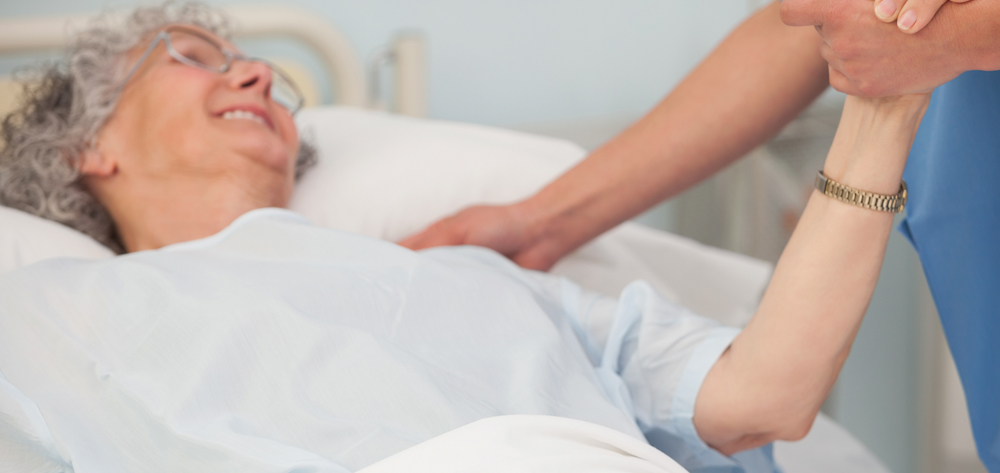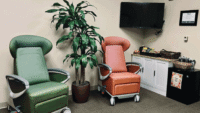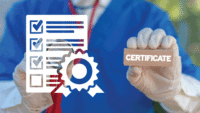To avoid injuring their patients and themselves, healthcare providers must get in the habit of using safe patient handling and mobility (SPHM) technology. In this supplement, national experts share their perspectives and best practices on topics ranging from dealing with bariatric patients, managing slings, and assessing a patient’s mobility to transforming the culture, building the business case for an SPHM, and developing a successful SPHM program.
In hospital settings, where the head of the bed (HOB) commonly is elevated, gravity causes patients to slide, or migrate, toward the foot of the bed. Nurses are well aware of this, as they’re regularly required to pull patients back toward the HOB if they can’t reposition themselves. A 1995 study at one hospital found nurses pulled patients up in bed an average of 9.9 times per shift. More recent evidence suggests this activity may be even more common in some hospitals and units.
Studies show that pulling patients who’ve migrated in bed carries an extremely high risk of caregiver injury. Less research has been done on the effects of migration on patients. This article describes how migration can affect patient outcomes, outlines relevant scientific evidence, and discusses strategies for managing patient migration.
Negative effects of migration
A 2013 study found that patients in traditional hospital-bed designs migrated about 13 cm (5″) when the HOB was raised to 45 degrees. Both bed movement and gravity cause patients to slide down in bed over time if the HOB is kept elevated. Such migration presumably causes friction and shear forces between the mattress and skin as the patient slides against the bed surface. Although friction and shear have been linked to pressure-ulcer formation, no research has evaluated whether friction and shear caused by migration directly contribute to pressure-ulcer risk.
Turning and repositioning patients who are morbidly obese
Hours per patient day: Understanding this key measure of productivity
As patients migrate toward the foot of the bed, the torso elevation decreases. A pilot investigation of 10 healthy subjects lying with the HOB at 30 degrees showed their torso angle was about 30 degrees when properly aligned with the hip indicator, compared to about 12 degrees when they migrated 23 cm (9″) past the hip indicator.
Positioning the HOB at or above 30 degrees is intended to reduce the risk of ventilator-
associated pneumonia (VAP) because torso elevation decreases the risk of aspirating gastric contents into the lungs. Once patients have migrated farther down the mattress, elevating the HOB may no longer reduce aspiration risk because their torsos are flatter. At that point, if they’re not repositioned, they may be at increased risk for VAP.
When patients migrate down in bed with the HOB up, they slide out away from the pivot of the HOB section and the lumbar spine goes unsupported, causing kyphosis. Kyphosis reduces lung capacity, so respiratory function may diminish in patients who’ve migrated. Although the relationship between kyphotic postures caused by migration and discomfort hasn’t been studied for hospital beds, it’s reasonable to expect migration would result in discomfort, especially in patients with low back pain or disc herniation.
Responding to patient migration
To help prevent negative outcomes associated with patient migration, be diligent in repositioning patients who’ve migrated downward. But be aware that repositioning is most likely to affect outcomes related to torso angle (such as VAP, reduced lung capacity, and discomfort)—not friction and shear linked to pressure-ulcer development. Among patients unable to boost or reposition themselves in bed, those on mechanical ventilators and those with back pain may be most in need of repositioning by the nurse.
Repositioning patients manually is associated with a high risk of musculoskeletal injury, so always use repositioning aids for patients unable to reposition themselves. Using lift equipment, such as a ceiling-mounted or mobile lift, is the best way to reduce healthcare worker strain, according to the American Nurses Association’s Safe Patient Handling and Mobility: Interprofessional National Standards, which calls for eliminating manual lifting in all healthcare settings.
If lift equipment isn’t available, use a friction-reducing sheet and place the bed in the Trendelenburg position (if the patient can tolerate it). If the patient is on an air surface, use the “max inflate” function. Patients who can provide partial assistance should participate in mobilization by placing their feet flat on the mattress and “bridging” when being repositioned. The patient also may pull on traction equipment, a trapeze bar, or the bed side rails, if available.
However, be aware that any method that involves manual lifting can cause injury to the nurse. One researcher found that based on the postures adopted when handling patients, caregivers who lift with forces above 16 kg (35 lb) are at increased risk of injury. The most effective way to prevent self-injury when repositioning patients is to use a ceiling-mounted or mobile lift. An air-assisted lateral transfer device also can be used to reposition the patient up in bed.
Preventing migration
Despite the impact of migration on patients and caregivers, little research exists on how to prevent it. The bed’s contribution to migration has been investigated in laboratory studies, but patient movement has yet to be studied.
To limit migration when articulating the bed, use auto-contour (a knee gatch that rises automatically and simultaneously as the HOB rises) to reduce migration by up to 2.5 cm (1″). If the bed doesn’t have auto-contour, raise the knee gatch before raising the HOB. Besides limiting migration from bed articulation, keeping the patient’s knees raised also may help limit migration over time. Of course, these strategies can be used only if the patient can tolerate knee bending.
Design of the bed-frame articulation seems to have an even bigger effect than auto-contour on the amount of patient migration. For example, across three different bed-frame designs, mean cumulative movement (total amount of sliding when raising and lowering the HOB) ranged from 13 to 28 cm (5″ to 11″). Most likely, migration caused by bed movement will continue to decrease as manufacturers develop beds more compatible with the changing geometry of the patient as the HOB rises. (See Considerations when purchasing hospital beds.)
More research is needed to confirm indications that patient migration toward the foot of the bed increases pressure-ulcer and VAP risk, causes patient discomfort, and reduces lung capacity. Many tools are available to help nurses safely reposition patients who’ve migrated. Using auto-contour when raising the HOB or the knee gatch may help prevent migration or slow its rate. Design of the bed’s articulation also affects the distance that a patient migrates.
Selected references
American Nurses Association. Safe Patient Handling and Mobility: Interprofessional National Standards. Silver Spring, MD: Author; 2013.
Bakker EW, Verhagen AP, van Trijffel E, Lucas C, Koes BW. Spinal mechanical load as a risk factor for low back pain: a systematic review of prospective cohort studies. Spine (Phila PA 1976). 2009;34(8): E281-93.
Bartnik LM, Rice MS. Comparison of caregiver forces required for sliding a patient up in bed using an array of slide sheets. Workplace Health Saf. 2013;61(9):393-400.
Drakulovic MB, Torres A, Bauer TT, et al. Supine body position as a risk factor for nosocomial pneumonia in mechanically ventilated patients: a randomised trial. Lancet.1999;354 (9193):1851-8.
Eriksen W, Bruusgaard D, Knardahl S. Work factors as predictors of intense or disabling low back pain; a prospective study of nurses’ aides. Occup Environ Med. 2004;61(5):398-404.
Kotowski SE, Davis KG, Wiggermann N, Williamson R. Quantification of patient migration in bed: catalyst to improve hospital bed design to reduce shear and friction forces and nurses’ injuries. Hum Factors. 2013;55(1):36-47.
Lin F, Parthasarathy S, Taylor SJ, et al. Effect of different sitting postures on lung capacity, expiratory flow, and lumbar lordosis. Arch Phys Med Rehabil. 2006;87(4):504-9.
Marras WS, Davis KG, Kirking BC, Bertsche PK. A comprehensive analysis of low-back disorder risk and spinal loading during the transferring and repositioning of patients using different techniques. Ergonomics. 1999;42(7):904-26.
Mehta RK, Horton LM, Agnew MJ, Nussbaum MA. Ergonomic evaluation of hospital bed design features during patient handling tasks. Int J Ind Ergon. 2011;41(6):647-52.
Metheny NA, Davis-Jackson J, Stewart BJ. Effectiveness of an aspiration risk-reduction protocol. Nurs Res. 2010;59(1):18-25.
Michel DP, Helander MG. Effects of two types of chairs on stature change and comfort for individuals with healthy and herniated discs. Ergonomics. 1994;37(7):1231-44.
Poole-Wilson T, Davis K, Daraiseh N, Kotowski S. Documenting the amount of manual handling performed by nurses in a hospital setting. Proceedings of 2014 Symposium on Human Factors and Ergonomics in Health Care: Leading the Way. Chicago, IL: The Human Factors and Ergonomics Society; 2014.
Skotte J, Fallentin N. Low back injury risk during repositioning of patients in bed: the influence of handling technique, patient weight and disability. Ergonomics. 2008;51(7):1042-52.
Vasiliadou A, Karvountzis GG, Soumilas A, Roumeliotis D, Theodosopoulou E. Occupational low‐back pain in nursing staff in a Greek hospital. J Adv Nurs. 1995;21(1):125-30.
Waters TR. When is it safe to manually lift a patient? Am J Nurs. 2007;107(8):53-9.
Wiggermann NE, Vangilder C, Davis K. Patient migration toward the foot of the bed affects torso angle. 2014 National Teaching Institute Research Abstracts. http://ajcc.aacnjournals.org/content/23/3/e19.full?sid=039ddc07-4db1-4bc4-aaca-5855cc684831#sec-175. Accessed July 15, 2014.
Williams MM, Hawley JA, McKenzie RA, van Wijmen PM. A comparison of the effects of two sitting postures on back and referred pain. Spine (Phila Pa 1976). 1991;16(10):1185-91.
Neal Wiggermann is a senior biomedical engineer and ergonomics specialist for Hill-Rom in Batesville, Indiana.


















7 Comments.
Aloha, it would be wonderful not having to worry about scheduling my transport all Doctors visits.Thank you. this information.
Quit using slippery sheets. I am a former nurse and today a patient. I feel exhausted fighting to stop from skidding in my bed . Sliding in bed pulls on underwater and pajamas and I will get butt burns and bed sore on my buttocks if I stay in this bed much longer. Slippery sheets are a bigger problem for patients. I was a nurse and we lifted with non slippery sheets. The sheet is stronger and less apt to slip under the patient.
Patients slide in bed because of slippery sheets. Do nurses really need slippery sheets. I am a patient and spend most of my energy trying to keep from slipping to the foot of the bed. Our beds adjust now and it is even harder to to not slide in bed. My underwater and pajamas slide too. Also I feel I could easily get a bed sore or sheet burn from slippery sheets. I lifted patients in my day as a nurse and we did not need slippery sheets. It is not necessary.
Is there anything that stops this migration? Or do we just keep pulling them up .
Carolyn – I don’t know how you’re managing now, or what type of bed you use for your son. However, I have experience trying to keep my Mom up in bed. I have a hospital bed, but raising the feet / knees is useless. Mom slides down on purpose. I use a draw sheet – just a twin sheet folded so that it reaches lower than the knees and under the arms. This sheet is placed beneath the pad / chux on the bed. I lower the head of the bed. Stand behind the bed. Use my legs against the back of the bed for leverage. Grasp the draw sheet at her shoulders and slowly pull toward me until she’s up in bed adequately. This has saved my back. If you’re spacially challenged, place a pillow behind your son’s head so that you’re aware and don’t pull too far. Prayers & well wishes!
If I am unable to keep my son from sliding down, is there some way to help me pull him back up?
I have been taking care of him for almost 20 years and when I began and was much younger and stronger than now. It is becoming every single day – I pray it will not eventually disable me – I cannot bear the thought of him having to go to a home, or not being able to care for him.
My heart is breaking every day, fearing for the future.
I would love to hear from anyone who might have a suggestion. We will gladly take your prayers also.
Ricky and his mom
That makes since to regularly reposition to deal with migration. That way you’ll maintain an optimal posture for patients. I bet remote controlled hospital beds could help the bed ridden service themselves with repostioning a lot of the time as well.